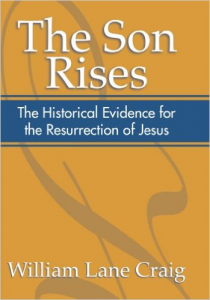
————————————————————————
==> An Amazon Link <==
—————————–
————–
An Amazon Review: By C. Prince
William L. Craig is perhaps the best-known apologist for the resurrection of Jesus. He set out his argument in detail in a book that unfortunately now costs well over $100. He has contributed articles on the resurrection to books like In Defense of Miracles and Jesus Under Fire. One of his debates on the resurrection has been converted into a book, Jesus’ Resurrection. What has been missing, and what this book provides, is a single volume treatment of Craig’s argument for the historicity of Jesus. The book is written for the layperson and weighs in at about 150 pages with relatively few references. As a popularization of Craig’s argument, it is success.
Craig begins with an introduction to the issues and a refutation of some popular counter theories, such as the apparent-death theory and the wrong-tomb theory. It seems odd placement given that he has not stated his case-in-chief, but Craig discusses them in terms of historical approaches to the resurrection. On one hand it adds some interesting historical context, but it still seems a little out of place.
The meat of the book is in the next two chapters, on the Empty Tomb and the Appearances of Jesus. Craig offers ten points supporting the historical fact of the empty tomb, beginning with “The historical reliability of the account of Jesus’ burial supports the empty tomb” to “The fact that Jesus’ tomb was not venerated as a shrine indicates that the tomb was empty.” Most of the arguments are persuasively presented, though I wish all apologists would leave the Shroud aside. But in the end, Craig adequately explains the reasons that most scholars, from diverse backgrounds, accept the empty tomb as historical fact.
The section on the Appearances of Jesus begins by demonstrating their historicity and then examines their explanations. He first shows that Peter, the Twelve, the five hundred, James, the apostles, and Paul did indeed experience appearances by Jesus. Craig then moves through the potential explanations and concludes that the best explanation for these appearances is that they were indeed real events, interactions with a living and breathing restored Jesus.
Craig caps off his argument with a discussion about the resurrection’s role as the best explanation for the Origin of the Christian Faith itself. He then concludes with a scholarly alter call, explaining the meaning of the resurrection of Jesus as the way to reconcile ourselves to God and gain forgiveness of our sins.
This book is typical of Craig. He moves through the material very methodically, laying out his arguments in an informed and convincing manner–step by step. He covers aspects of the argument in other publications in more depth or with more references, but The Son Rises is beneficial in that it brings the core of his argument, and the significance of his conclusion, together in one small book.